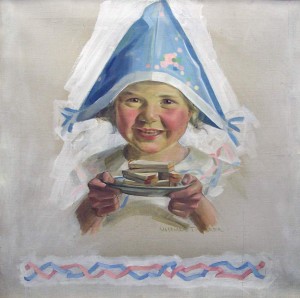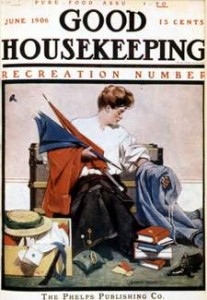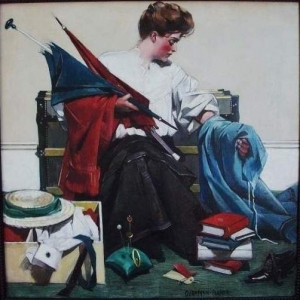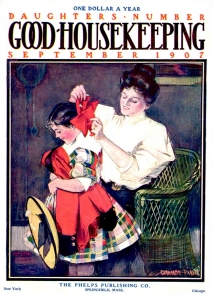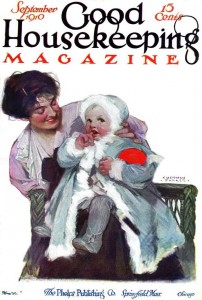Maybe you’re like me and when you think of the 20th century illustrator Cushman Parker, you think of the myriad of advertising illustrations he created in the teens and 20s of cherry cheeked children enjoying a variety of Beech-Nut products.*
Cushman Parker (1881-1940)
Beech Nut Advertisement, c. 1920
Advertising illustration for Beech Nut Peanut Butter
Paint on paper
Norman Rockwell Museum Collection, gift of Mr. and Mrs. Steven R. Hirsch, NRM.2008.09
The artistic convention of the 1920s and 30s was to illustrate smiling children with bright pink cheeks (look at contemporaneous illustrations by Ellen Bernard Thompson Pyle for comparison). For the Beech-Nut peanut butter ad seen above, Cushman Parker painted those pink cheeks so strikingly that it might look exaggerated to us today. Since this image was to be incorporated into a Beech-Nut ad, Parker did not bother to complete a background, but merely used white paint around the child to provide clean looking print-ready art. While it would be difficult to estimate how many ad illustrations Parker created for Beech-Nut in the teens and 20s, we can get some idea of the scope of his work via the google books digitized copy of 1917 copyright records available online. Published in 1918, the February listing of Beech-Nut ads illustrations by Cushman Parker that were given copyrights number 33.** For identification reasons I’m sure, each ad was listed by a boy or girl’s name beginning with the letter B, such as, “Beulah Beech-nut; by Cushman Parker,
In addition to ads for Bon Ami cleaning powder and Welch’s Grape Juice, Parker produced a memorable ‘support our troops’ poster for the United States Food Administration. In 1909 he produced a collection of paper dolls called “Little Louise” published serially in Good Housekeeping magazine. Between 1909 and 1915 Cushman Parker also produced other collections of paper dolls published by the George W. Jacobs & Co., out of Philadelphia called Dorothy Dimple and her friends: Paper Dolls of Many Nations by Cushman Parker. ***
With such a diverse range of illustration work, we should not be surprised to learn that between August 1905 and September 1910 Cushman Parker produced 18 cover illustrations for Good Housekeeping magazine. The subject matter of these cover illustrations are mostly of children, a mother with a child, or of a pretty woman.
Cushman Parker (1881-1940)
[Girl Packing Trunk]
Cover illustration for Good Housekeeping (June 1906)
Oil on
Collection of Shhhboom Gallery
In the above cover illustration created for the summer “Recreation Number” a young lady sits amidst piles of things to be packed (a woman’s worn walking shoe; five books of various length; a pin cushion with three hat pins stuck into it and an oval dress pin; and a box of clothing including a green ribbon decorated boater hat.) Between the books and the pin cushion, the shipping label to be attached to her steamer trunk in the background sits on the floor. Recognizing that there might be some inclement weather during her summer recreation, the young lady holds one umbrella in red, and a smaller parasol in blue and has a red cardigan sweater folded over her arm; across her lap is her Macintosh with the attached cape just visible. Folded over her opposite arm is a lighter-toned blue skirt with a darker blue stripe of trim near the hem—notice the tapes that secure it around her waist hanging from the skirt’s waist. Already in the trunk tray to her right is a white blouse, perhaps meant as the companion for the skirt on her arm. The blue button on the blouse cuff and the blue tie handing over the side of the box match the darker blue of the skirt’s hem. Like the blouse the young lady is wearing, this style of blouse is popularly called a shirt-waist. The woman’s boater hat, the shirt-waist, and the soft looser style of wearing her hair, mark this illustration as being of the time of the popular Gibson girl, even though this illustration is obviously not by Gibson. It is clear from the size of the trunk behind her, that she has just begun her packing.
Many of Parker’s Good Housekeeping women are of this same sort: active–even athletic, dressed in contemporary styles, and when pictured with children they are actively engaged with them. And like the three seen in this essay, Parker appears to use the same models ( including the wicker chair seen below) a variety of times.
And Cushman Parker’s images of the children he includes in the interactions? Rosy cheeked one and all.
I would like to thank Tim and Michelle Smith of Shhhboom Gallery for sharing their finds of a group of Good Housekeeping cover illustrations by Cushman Parker with me.
*Beech-Nut manufactured canned fruits and vegetables, gum, coffee, jams, jellies, peanut butter, and baby foods. Advertising said “that Beech-Nut offered ‘everything for breakfast but the eggs.’” See, Smith, Andrew F., ed., The Oxford Companion to American Food and Drink (New York: OxfordUniversity Press, 2007): 42.
** Catalog of copyright entries: Works of art, Vols. 11-12. (Washington, DC: Library of Congress, 1918), see https://books.google.com/books?id=h0EhAQAAIAAJ&pg=PA2&lpg=PA2&dq=%22Cushman+Parker%22&source=bl&ots=cV57MUCO57&sig=Wj6_rYdQp1bXhFGsu5OFOJ14nTA&hl=en&sa=X&ei=hWflUbnULrK14APApIHgAw&ved=0CHMQ6AEwDg#v=onepage&q=%22Cushman%20Parker%22&f=false
*** In the Manual of Play by William Byron Forbush (Philadelphia, Pa.: George W. Jacobs & Co., 1914) : 304; Dorothy Dimple and Her Friends is described as being comprised of “packets . . . [containing] six cut-outs, . . . representing a little American girl and her friends, with various costumes for each, and the latter, six children of as many different countries, with appropriate costumes for each country.”
October 17, 2013
By Joyce K. Schiller, Curator, Rockwell Center for American Visual Studies, Norman Rockwell Museum


